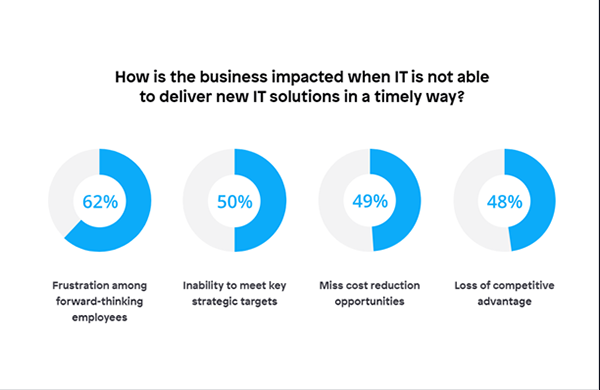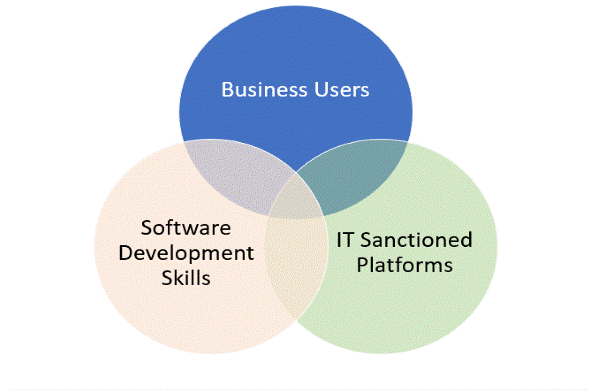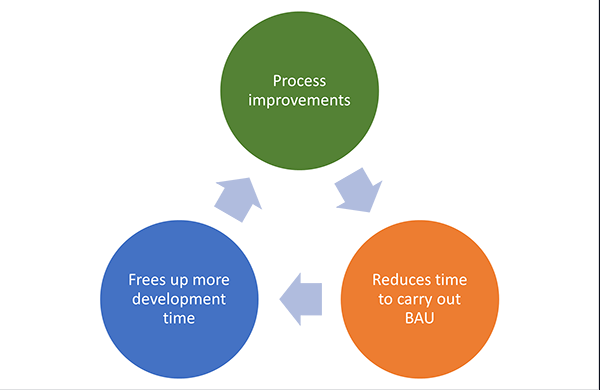AuraQ has vast experience helping organisations find the gaps that can be filled to enhance their business. This could be to improve efficiency, integrate legacy systems or deliver new portals and strategic applications to create competitive advantage. Contact us to request a free, no obligation Gap Analysis.
When to use citizen developers?
We all know the feeling – you have a process which you loathe doing because it is time consuming, complex and (despite being critical to the business) is very error prone meaning that you have to double check everything before you send it out. The problem is…. you are too busy following the existing process to have the time to sit down and work out what the process should be in an ideal world! Even if you had the time, securing resource from IT departments to build the solution is always difficult – especially as you are asking them to replace something that already exists. This can have a detrimental impact on the business as seen below in Image 1 (Source – Digital Disconnect: A Study of Business and IT Alignment) Cue, citizen developers.
What is a citizen developer?
“A citizen developer is an employee who creates application capabilities for consumption by themselves or others, using tools that are not actively forbidden by IT or business units. A citizen developer is a persona, not a title or targeted role. They report to a business unit or function other than IT.” – Gartner
Business users are the driving force behind any business change. They are the subject matter experts who define what a system or application should deliver and how it will be used. Traditionally, their vision has had to be translated into requirements by a business analyst and subsequently passed to a developer to build. This can be a slow and expensive process. When IT don’t have the resources, often business users who have some technical skills end up building their own solutions using tools and languages such as Excel or SQL, without any governance or oversight. These ‘Shadow IT’ solutions often satisfy the business need, but since they are not supported by IT, they carry an inherent business continuity risk. A third option is becoming increasingly available to companies. Tools such as low-code/no-code platforms have made it far easier and much more accessible for people to create their own solutions with the use of IT approved technology. These platforms enable business users to become citizen developers and it’s a trend that is rapidly on the rise.
According to a recent Gartner report, 61% of organisations either have or plan to have active citizen development initiatives. Business experts are able to build high-impact solutions without reliance on the resources of IT departments because the visual nature of these tools empower users of varying skill sets to build solutions, while controls over what gets deployed into live allow IT to maintain the level of oversight, they need to ensure business continuity. Professional developers are also increasingly using these low-code/no-code platforms, but more about that later in this post.
Agility creates time
So how do people who are hired to do an operational role but want to become citizen developers find the time to develop new solutions while maintaining their day job? The key is agility and working in an agile manner. The Agile approach to software development involves breaking up work into a series of ‘Sprints’. Each Sprint delivers usable functionality to the business as quickly as possible. Citizen developers will often have limited development time because of other business commitments. By prioritising features that reduce BAU workload into earlier Sprints, the time saved can then be re-invested back into the development of the further features and deliver more material benefits to the business.
Positive feedback time loops
A good example of this concept in practice comes from my time working in the medical records library of a hospital. It was my job to process several reports each day to produce lists of patient files to be pulled from the warehouse and sent to various locations around the hospital. This is a fairly standard task in an operations role, however the processes I inherited were very manual, rigid and not particularly robust.
There was clearly an opportunity to build a better solution, and although management within the hospital were supportive of change, there was no budget. The only way to improve things was for me to do it myself – citizen development in practice. The problem was, since the reports were so time consuming to run, I only had about an hour a day to devote to creating improved processes. For the first Sprint, I focused on automating the most time-consuming task; the importation process that converts the report into raw data. There were other steps in the process which would have produced a better output, and therefore a more tangible benefit, but the priority initially was timesaving, and this shaved about two hours off the daily process. This quickly gave me the time required to work on developing the solution further and each subsequent iteration freed up more time, allowing me to develop more, and so on…
Within a few months, I had completely reversed the timescales – it now took about an hour a day to run the process, leaving me with the rest of the day to work on parts of the process that added a material benefit in terms of cost saving and risk reduction. This shows how using citizen developers, and some clever Sprint planning, can provide you with development time that was non-existent at the start of the project.
When should you use citizen developers?
Citizen developers are not the answer to all of life’s problems. When coming up with a solution or application that re-invents the wheel, you usually want to engage with more experienced developers. They provide a deeper understanding of computer science, enabling them to optimise a solution and ensure complexity doesn’t impact performance. Where citizen developers are most useful is continuous improvement projects. Their closeness to both the problem and solution means they are uniquely placed to come up with the best solution. This is why citizen developers and the Agile methodology go hand in hand as both are designed to bridge the gap between the end user and the development process.
How to support citizen developers
Even if you are willing to invest the time required to develop a solution from within a team, there is often reluctance from managers to combine ‘production’ resource with ‘development’ resource as it can create a single point of failure. Based on more traditional technology, I can understand where this concern comes from. I have seen countless situations where someone leaves a team, and their replacement is left to use a business-critical tool which they not only have no idea how they work, but because they are new to the business, they don’t really know how they are supposed to work. This is another area where low-code/no-code platforms help. By providing an environment where business users are empowered to build the applications they need, but to do so within a structure governed and supported by IT, managers can be assured that whatever their citizen developers create can be supported in the long-term with approved technologies.
Laying foundations in low-code
In addition to business users, professional developers are increasingly using low-code/no-code platforms. The same simplicity that makes them accessible to non-coders also allows those with development experience to create complex solutions far faster than using traditional coding languages. The visual language also allows developers to engage with business users on their terms, facilitating a common understanding and collaboration between the two allowing the business to become more involved in the development lifecycle. Having professional developers working on the same platform enables citizen developers to create downstream or cross-functional solutions. For example, a developer could create a complex forecasting tool for the operations team, then a citizen developer in the finance team could use the model they created to build a tool for their reporting needs. In this way, low-code/no-code platforms can become the foundations for companies to create bespoke, enterprise level software that connect different parts of the business.











